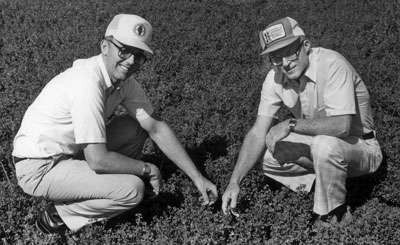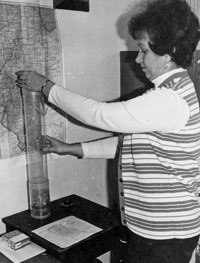|
FIELD INSPECTION
SERVICES
Field Inspection
Services are one
of the most
important services
offered by ICIA. If
you are going to
produce quality
seed, someone has to
“put on their boots”
and go to the field
and look at the
growing crop to
determine if there
are any varietal
purity or weed
problems. In other
words, field
inspections are a
critical step in
assessing whether a
field will be “just
grain” or quality
seed. ICIA always
prided itself in
having great
inspectors and tried
to recruit enough
each year so that
field inspection
could be done in a
timely manner
throughout the
state. Being a field
inspector was a good
part-time occupation
for a retiree,
student, or school
teacher with after
school or summer
availability.
 |
|
James
Shearl
with
Dr.
Don
Graffis,
observing
certified
alfalfa
|
|
ICIA inspectors
served four
important roles;
doing the required
field inspections
and the associated
paperwork, gathering
bulk samples of
uncleaned seed,
collecting the
official clean
sample and acting as
the Association’s
representative in
the field. In those
services, uniform
and unbiased
procedures must be
followed to assure
the integrity of the
certified seed
program. The fourth
inspector role,
representative in
the field, put a
local face on ICIA
to assist the
customer in proper
procedures and
questions. The
methods for doing
field inspection and
seed sampling
(sequential counting
and specific
sampling steps based
on the size of the
seed lot) have been
developed over time
by representatives
of seed
certification
organizations in
concert with state
and federal
governments. These
procedures help
seedsmen collect
data and information
to determine if seed
is worthy of being
offered for sale.
In field inspection,
the inspector must
enter the field at
the proper time in
the life cycle of
the plant and
sequentially walk
the field, taking
notes for varietal
purity, presence of
any weeds, and
general information
as to health of the
crop. The task
involves a lot of
walking in standing
crop during all
elements from heat
to wetness.
Inspectors earn
their pay on
inspection days.
 |
|
Paul
Palmgren,
inspecting
soybeans |
|
During seed
sampling, official
procedures must
again be followed to
ensure all parties
that an official
sample had been
obtained. Bin
sampling work was
especially important
during 1973-97
because a lot of
Illinois certified
seed was sold in
bulk as a wholesale
transaction. Getting
a representative
sample of seed from
a bin was sometimes
difficult depending
on the access to the
storage facility,
seed quantity
available and the
required sample
size. Bulk sampling
was usually
accomplished in the
fall or winter ahead
of conditioning and
before sale to the
end user. Being in
the fall, the work
was usually cold and
did involve climbing
and a certain amount
of risk. Field
inspectors are to be
commended for their
dedicated service to
ICIA.
Inspectors did also
have some lighter
moments. For
example, Paul
Palmgren, who joined
ICIA in May of 1974,
and headed up field
inspection for most
of this 25 year time
period, along with
Richard Denhart, his
predecessor, can
present the humorous
side of field
inspection and
official seed
sampling that will
invoke tears from
laughter. Richard
always liked to tell
stories about bin
sampling seed. He
would tell of
preparing to pull a
sample out of the
old Hoffman Farm
wooden corn crib out
in a remote area
west of Monticello,
Illinois. This crib
was part of the U of
I Allerton Farms and
one of the largest
in Illinois before
it was tragically
lost in a fire. The
crib was converted
to grain storage
bins and the only
access was from way
up in the top where
the overhead bins
were located.
According to Rich,
he climbed the
rickety ladder, and
with his best
agility, maneuvered
his way down the
center board which
was covered with
raccoon droppings to
the center of the
crib. With the 6
foot brass grain
probe in one hand
and sample bags in
the other, he almost
jumped down into the
dark bin thinking it
was full of
soybeans. For some
reason, he threw the
probe in first.
There was a period
of silence and then
the metallic clank
of the probe hitting
25 foot below on
bare wood. No seed
to break his fall.
 |
|
Joan
Opolka,
working
on
oat
sample |
|
One of Richard’s
favorite stories was
admitting he always
wanted to be 6’6,”
but really realized
it one afternoon
when he jumped off
into a bin of
soybeans, filled his
sample bags, and
then realized he was
just a bit too short
to reach the top of
the bin. He was
alone and
contemplated his
plight for quite
some while. He was
sure he would be
found in the spring
when they sold the
crop. He finally got
out by piling
soybeans up on the
side of the bin and
running up to grab
the top of the bin
and pull himself
out. Being Chief
Inspector at ICIA
never has had a
height requirement;
it was just a good
idea to be agile and
a good jumper.
Then Paul would get
going on some of his
“Paulisms”. For some
reason, when doing
inspector training
schools, he would
always clear his
throat, like only he
can do, and then
remind new recruits
when they enter a
new farmstead to
always “watch out
for the 300 pound
dog before getting
out of the car.”
The Four Legged
Inspector: At
one farmstead, a
goat was quick to
get into Paul’s car
and settle into the
right front seat. No
amount of effort
could get it out
until Paul opened
all the doors and
the tailgate and
walked a distance
away. After about a
half hour, the goat
decided to find
something else to
do. Other
admonishments would
prohibit the use of
rickety ladders and
declare that the
raccoons always had
the right of way
when coming head to
head on the crib
ladder. Situational
awareness at the bin
site was always very
important.
Laughter is good for
the soul. Being able
to laugh with
co-workers is
especially important
to the health and
effectiveness of an
organization and
such a relationship
existed at ICIA. All
kidding aside, both
Paul and Richard did
a great job of
giving training and
leadership to the
ICIA inspection
team. |